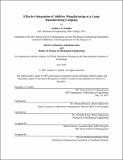Effective Integration of Additive Manufacturing at a Large Manufacturing Company
Author(s)
Fabian, Andrew S.
DownloadThesis PDF (2.106Mb)
Advisor
Roemer, Thomas
Fang, Nicholas
Terms of use
Metadata
Show full item recordAbstract
Additive manufacturing (AM) has the potential to create significant value at large manufacturing companies such as Corning, but to date adoption has been slow. Corning invested in AM early, establishing a central AM team in 2006. While the team has developed technical AM expertise and supports numerous projects, there are a number of organizational and technical challenges limiting the more effective integration of AM at Corning. These challenges include lack of AM knowledge across the company, lack of a coordinated AM effort, conflicting financial expectations, and technical limitations. Despite these challenges, the Corning AM team has developed successful practices such as a tailored business model for supporting projects and an internally recognized level of technical expertise that has led to a number of wins including repeat customers and direct involvement in a project considering AM for high-volume production. To support more effective integration and adoption of AM, this research proposes a framework for understanding these challenges and five best practice initiatives to overcome them: spread AM in-depth knowledge through targeted training to better educate stakeholders, provide clear information about AM capabilities and costs, coordinate AM efforts across the company, leverage relationships to overcome organizational inertia, and identify and invest in high impact technical gaps. To further support AM adoption, this research proposes a roadmap for the qualification of metal Laser Powder Bed Fusion (L-PBF) AM for high volume production, a pre-identified technical gap. This is a need of a high-profile project at Corning which has design requirements that make AM a prime production candidate. This roadmap provides a thorough understanding of qualification processes and requirements for AM, allowing for a reduction of technical and financial risk for projects utilizing AM for production.
Date issued
2021-06Department
Massachusetts Institute of Technology. Department of Mechanical Engineering; Sloan School of ManagementPublisher
Massachusetts Institute of Technology